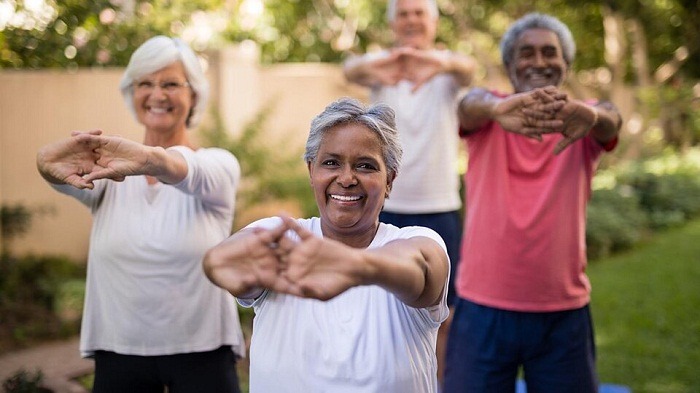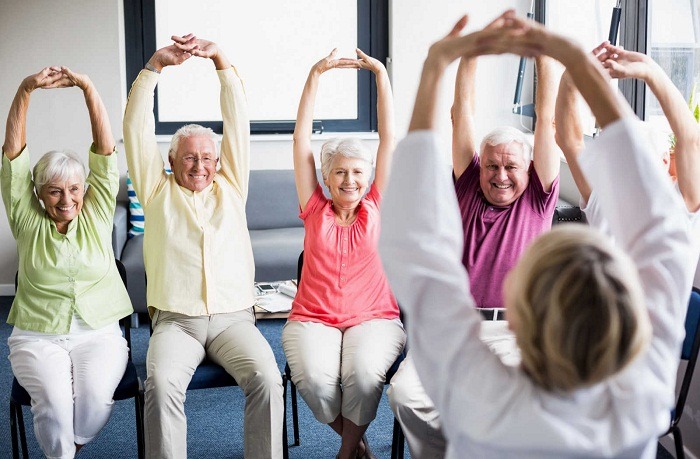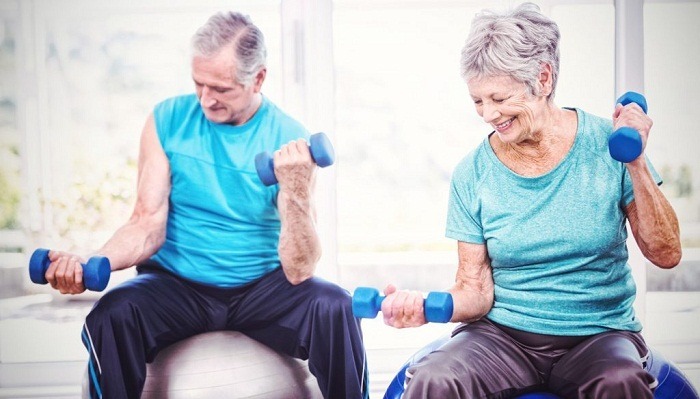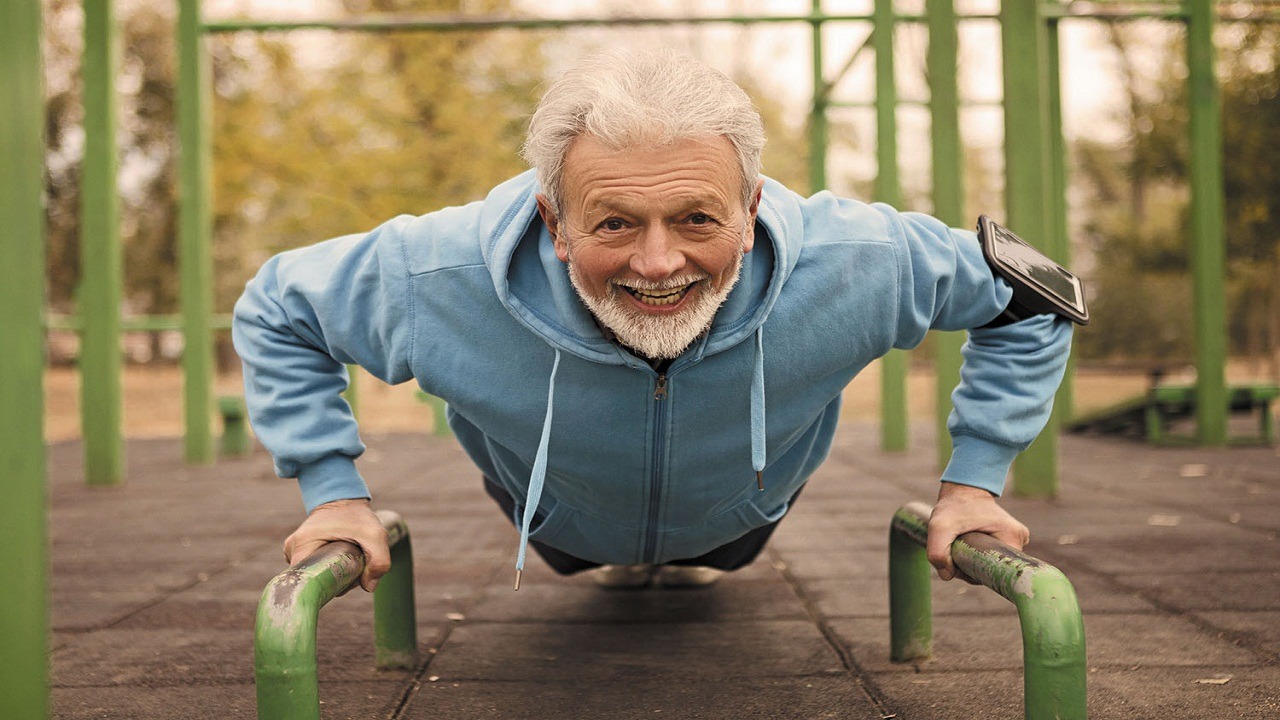Understanding the Aging Process and Exercise
Contents
- 1 Understanding the Aging Process and Exercise
- 2 Importance of Exercise for Seniors:
- 3 Physical Benefits:
- 4 a. Muscle Strength and Aging
- 5 b. Bone Health and Exercise
- 6 c. Flexibility and Balance: Keys to Mobility
- 7 Mental and Emotional Well-being:
- 8 a. Cognitive Benefits of Exercise
- 9 b. Mood Enhancement through Physical Activity
- 10 Disease Prevention:
- 11 a. Cardiovascular Health and Seniors
- 12 b. Exercise for Diabetes Management and Prevention
- 13 c. Arthritis and the Role of Physical Activity
- 14 Safe and Effective Exercises for Seniors:
- 15 Cardiovascular Exercises:
- 16 a. The Power of Walking
- 17 b. Dive into Fitness: Swimming for Seniors
- 18 c. Cycling for Health and Happiness
- 19 Strength Training:
- 20 a. Bodyweight Mastery: Exercises without Equipment
- 21 b. Resistance Bands: Lightweight Powerhouses
- 22 c. Light Weights for Lasting Strength
- 23 Flexibility and Balance Exercises:
- 24 a. Yoga for Seniors: A Gentle Approach
- 25 b. Tai Chi: The Art of Mindful Movement
- 26 c. Stretching for Suppleness
- 27 Functional Exercises:
- 28 a. Seated Success: Chair Exercises for All
- 29 b. Climbing to New Heights: Stair Exercises
- 30 Tips for Safe Exercise:
- 31 Consult with Healthcare Professionals:
- 32 a. Importance of Medical Guidance
- 33 b. Tailoring Exercise Plans to Individual Health Needs
- 34 Start Slow and Progress Gradually:
- 35 a. The Gentle Approach to Fitness
- 36 b. Recognizing Personal Limits
- 37 Warm-Up and Cool Down:
- 38 a. Preparing the Body: The Warm-Up Routine
- 39 b. Cooling Down: A Vital Post-Exercise Ritual
- 40 Stay Hydrated:
- 41 a. Hydration Essentials for Seniors
- 42 Use Proper Equipment:
- 43 a. The Right Gear for Safe Workouts
- 44 b. Ensuring Equipment Safety
- 45 Listen to Your Body:
- 46 a. The Body’s Communication
- 47 b. Post-Exercise Reflection
- 48 FAQs
- 49 What is the most beneficial exercise for seniors?
- 50 What is the best exercise for a 60-year-old?
- 51 What is the best time of day for seniors to exercise?
- 52 What is the best home exercise equipment for seniors?
- 53 What are the four main types of exercise that seniors need to stay healthy?
- 54 Is walking the best exercise for seniors?
- 55 Is 30 minutes of walking a day enough exercise?
- 56 What is the most important exercise for seniors to master?
- 57 What is a good distance to walk daily?
- 58 Should seniors exercise every day?
- 59 How much exercise per day?
- 60 What is the best form of exercise?
- 61 How do seniors build muscle?
- 62 How can seniors improve balance?
- 63 What is the best exercise for seniors to strengthen their legs?
- 64 Which food is good for strong legs?
- 65 What can the elderly eat for weak legs?
- 66 How can I make my weak legs strong again?
- 67 Conclusion:
- 68 Fostering a Fulfilling and Active Lifestyle in Golden Years
As individuals age, the body undergoes various physiological changes, including a decline in muscle mass, bone density, and overall physical function. Engaging in regular exercise becomes increasingly vital to counteract these effects and maintain a healthy, active lifestyle. This introduction will delve into the Best Exercises for Seniors Over 50 and the specific challenges they face and highlight the role exercise plays in mitigating these challenges for improved well-being.
Also Read: Why Does Phentermine Make Me Calm? | All You Need To Know
Importance of Exercise for Seniors:
Physical Benefits:
a. Muscle Strength and Aging
Explore the connection between aging and muscle loss, elucidating how resistance training can be a powerful tool to combat this natural decline. Discuss specific exercises that target different muscle groups, ensuring a comprehensive approach to maintaining and building strength in seniors.
b. Bone Health and Exercise
Delve into the significance of weight-bearing exercises in preserving bone density, crucial for preventing osteoporosis. Provide a range of weight-bearing exercises suitable for seniors, emphasizing both safety and effectiveness.
c. Flexibility and Balance: Keys to Mobility
Examine the importance of flexibility and balance in promoting overall mobility, independence, and fall prevention among seniors. Present a variety of exercises and activities that enhance flexibility and balance, making daily movements more manageable.
Mental and Emotional Well-being:
a. Cognitive Benefits of Exercise
Explore scientific findings on how regular exercise positively impacts cognitive function and reduces the risk of cognitive decline in seniors. Highlight specific exercises that have shown cognitive benefits and discuss the potential long-term effects on brain health.
b. Mood Enhancement through Physical Activity
Investigate the relationship between exercise and mood, focusing on the release of endorphins and its impact on mental well-being. Provide insights into exercises that promote a positive mood and alleviate symptoms of depression and anxiety in seniors.
Disease Prevention:
a. Cardiovascular Health and Seniors
Examine the role of cardiovascular exercises in maintaining heart health among seniors. Discuss appropriate aerobic activities, their benefits, and the recommended frequency and intensity for optimal cardiovascular fitness.
b. Exercise for Diabetes Management and Prevention
Explore how exercise contributes to improved insulin sensitivity and helps manage or prevent type 2 diabetes in seniors. Provide practical guidelines for incorporating exercise into a diabetes prevention or management plan.
c. Arthritis and the Role of Physical Activity
Discuss how arthritis symptoms can be alleviated through specific exercises, focusing on gentle movements that promote joint flexibility and reduce inflammation. Highlight the importance of tailored exercise routines for individuals with arthritis.
Safe and Effective Exercises for Seniors:

Cardiovascular Exercises:
a. The Power of Walking
Examine the benefits of walking as a low-impact cardiovascular exercise for seniors. Provide tips on incorporating daily walks into their routine, adjusting intensity based on individual fitness levels.
b. Dive into Fitness: Swimming for Seniors
Explore the advantages of swimming, an excellent full-body workout that minimizes impact on joints. Discuss water aerobics and other aquatic exercises suitable for seniors of varying abilities.
c. Cycling for Health and Happiness
Highlight the benefits of cycling, both stationary and outdoors, for seniors. Discuss how cycling contributes to cardiovascular health and share safety precautions and equipment recommendations.
Strength Training:
a. Bodyweight Mastery: Exercises without Equipment
Explore bodyweight exercises that seniors can perform to build and maintain muscle strength without the need for additional equipment. Provide variations based on fitness levels and discuss the importance of proper form.
b. Resistance Bands: Lightweight Powerhouses
Discuss the versatility of resistance bands in strength training for seniors. Present a range of exercises using these portable tools and highlight their effectiveness in promoting muscle tone.
c. Light Weights for Lasting Strength
Examine the benefits of using light weights in strength training for seniors. Guide on choosing appropriate weights, designing routines, and ensuring safety during lifting exercises.
Flexibility and Balance Exercises:
a. Yoga for Seniors: A Gentle Approach
Explore the world of senior-friendly yoga, emphasizing its role in improving flexibility, balance, and relaxation. Provide examples of yoga poses tailored to the unique needs and abilities of older individuals.
b. Tai Chi: The Art of Mindful Movement
Discuss the ancient practice of Tai Chi and its benefits for seniors, focusing on slow, controlled movements that enhance balance, coordination, and overall physical well-being.
c. Stretching for Suppleness
Examine the importance of regular stretching routines in promoting flexibility and reducing the risk of muscle stiffness and injury. Provide a comprehensive guide to safe and effective stretching exercises for seniors.
Functional Exercises:
a. Seated Success: Chair Exercises for All
Highlight the accessibility of seated exercises for seniors with mobility challenges. Provide a range of chair exercises that target various muscle groups, promoting strength and flexibility.
b. Climbing to New Heights: Stair Exercises
Discuss the benefits of stair climbing as a functional exercise for lower body strength and cardiovascular fitness. Provide safety tips and alternative options for seniors with varying levels of mobility.
Tips for Safe Exercise:

Consult with Healthcare Professionals:
a. Importance of Medical Guidance
Emphasize the necessity of consulting healthcare professionals before embarking on a new exercise routine. Guide the type of information seniors should share with their healthcare providers to ensure personalized advice.
b. Tailoring Exercise Plans to Individual Health Needs
Discuss how healthcare professionals can help tailor exercise plans based on individual health conditions, limitations, and goals. Address common concerns and misconceptions about exercise for seniors.
Start Slow and Progress Gradually:
a. The Gentle Approach to Fitness
Highlight the importance of starting with low-intensity exercises and gradually increasing intensity and duration. Provide a step-by-step guide on how seniors can progressively build their fitness levels.
b. Recognizing Personal Limits
Guide seniors in listening to their bodies and recognizing signs of fatigue or discomfort. Discuss the importance of rest and recovery in preventing overexertion and injuries.
Warm-Up and Cool Down:
a. Preparing the Body: The Warm-Up Routine
Discuss the components of an effective warm-up routine, including light cardio and dynamic stretches. Emphasize the role of warm-ups in preventing injuries and improving overall exercise performance.
b. Cooling Down: A Vital Post-Exercise Ritual
Explore the benefits of cooling down after exercise, focusing on static stretches that aid in flexibility and reduce muscle soreness. Provide a sample cooldown routine suitable for seniors.
Stay Hydrated:
a. Hydration Essentials for Seniors
Examine the importance of staying hydrated during exercise, especially for seniors. Discuss factors that may increase the risk of dehydration and provide practical tips for maintaining proper fluid balance.
Use Proper Equipment:

a. The Right Gear for Safe Workouts
Discuss the significance of wearing appropriate footwear for exercise, especially for weight-bearing activities. Provide recommendations for supportive shoes and address the role of other equipment in ensuring safe workouts.
b. Ensuring Equipment Safety
Explore the importance of checking the condition of exercise equipment and ensuring its safety before use. Provide a checklist for seniors to follow when using home gym equipment or participating in group classes.
Listen to Your Body:
a. The Body’s Communication
Educate seniors on paying attention to signals from their bodies during exercise. Discuss common signs of overexertion, pain, dizziness, or shortness of breath, and emphasize the importance of seeking professional advice when needed.
b. Post-Exercise Reflection
Guide seniors in reflecting on their post-exercise experiences, including any discomfort or unusual sensations. Discuss how self-awareness contributes to a safer and more enjoyable exercise routine.
FAQs
What is the most beneficial exercise for seniors?
The most beneficial exercise for seniors is a combination of cardiovascular, strength training, flexibility, and balance exercises. This holistic approach ensures comprehensive health benefits, including improved cardiovascular fitness, muscle strength, joint flexibility, and reduced risk of falls.
What is the best exercise for a 60-year-old?
The best exercise for a 60-year-old varies based on individual preferences and health conditions. However, a well-rounded fitness routine that includes cardiovascular activities (like walking or swimming), strength training, and flexibility exercises is generally recommended. Consulting with a healthcare professional can help tailor an exercise plan to specific needs.
What is the best time of day for seniors to exercise?
The best time of day for seniors to exercise is often in the morning when energy levels tend to be higher. However, the most important factor is consistency. Choose a time that aligns with personal preferences and allows for regular exercise, whether it’s morning, afternoon, or evening.
What is the best home exercise equipment for seniors?
The best home exercise equipment for seniors includes items that are safe, easy to use, and target various muscle groups. Examples include resistance bands, light dumbbells, stability balls, and stationary bikes. Choose equipment that suits individual fitness levels and preferences.
What are the four main types of exercise that seniors need to stay healthy?
Seniors need a combination of cardiovascular exercises (e.g., walking), strength training (with resistance or bodyweight exercises), flexibility exercises (like yoga or stretching), and balance exercises (such as Tai Chi) to maintain overall health and well-being.
Is walking the best exercise for seniors?
While walking is an excellent low-impact exercise for seniors, the best exercise depends on individual preferences and health conditions. A well-rounded routine that includes various types of exercises is generally more beneficial for overall health.
Is 30 minutes of walking a day enough exercise?
Yes, 30 minutes of walking a day is a good starting point for maintaining cardiovascular health. However, seniors can enhance their overall fitness by incorporating strength training, flexibility, and balance exercises into their routine.
What is the most important exercise for seniors to master?
The most important exercise for seniors to master is one that focuses on balance. Activities like Tai Chi or specific balance exercises can significantly reduce the risk of falls, which is crucial for maintaining independence and preventing injuries.
What is a good distance to walk daily?
A good distance to walk daily for seniors is around 30 minutes to an hour, covering approximately 2 to 4 miles. However, the ideal distance varies based on individual fitness levels, and it’s essential to listen to the body and gradually increase intensity.
Should seniors exercise every day?
Seniors can benefit from exercising most days of the week. However, it’s crucial to include a variety of exercises to avoid overuse injuries. Consult with healthcare professionals for personalized recommendations based on individual health conditions.
How much exercise per day?
Seniors should aim for at least 150 minutes of moderate-intensity aerobic exercise per week, along with strength training exercises at least two days a week. This can be broken down into manageable sessions throughout the week.
What is the best form of exercise?
The best form of exercise is a combination of cardiovascular, strength training, flexibility, and balance exercises. A well-rounded routine ensures overall health benefits, addressing various aspects of physical fitness.
How do seniors build muscle?
Seniors can build muscle through strength training exercises, using either bodyweight, resistance bands, or light weights. It’s essential to start with a manageable intensity and gradually increase resistance as strength improves.
How can seniors improve balance?
Seniors can improve balance through activities like Tai Chi, yoga, and specific balance exercises. These activities help enhance stability, and coordination and reduce the risk of falls.
What is the best exercise for seniors to strengthen their legs?
The best exercises for seniors to strengthen their legs include squats, lunges, leg presses, and calf raises. These exercises target various muscles in the legs, promoting strength and stability.
Which food is good for strong legs?
Foods rich in nutrients like protein, calcium, and vitamin D are beneficial for strong legs. Include sources of lean protein, dairy or fortified plant-based milk for calcium, and foods rich in vitamin D in the diet.
What can the elderly eat for weak legs?
Elderly individuals with weak legs should focus on a balanced diet that includes protein-rich foods, whole grains, fruits, and vegetables. Additionally, staying hydrated and incorporating foods rich in vitamins and minerals is essential for overall leg health.
How can I make my weak legs strong again?
To make weak legs strong again, engage in regular strength training exercises targeting the leg muscles. Include a balanced diet, and proper hydration, and consult with healthcare professionals for personalized guidance based on individual health conditions.
Conclusion:
Fostering a Fulfilling and Active Lifestyle in Golden Years
Summarize the key points discussed in the article, reinforcing the idea that incorporating safe and effective exercises into daily routines is essential for seniors to enjoy optimal health and well-being. Encourage readers to take the first step toward a healthier lifestyle, promoting a fulfilling and active journey throughout their golden years.

